How to soundproof an apartment door: 7 Easy DIY Solutions
Today, I want to show you how to soundproof an apartment door using straightforward methods that will not cost you an arm or a leg.
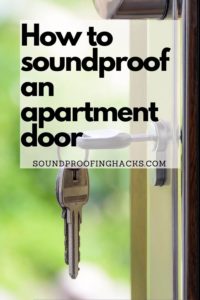
We’ve all been in a situation where we’ve had to put up with noisy neighbors who seem to do all their chores in the middle of the night.
Alternatively, you could be the noise-making culprit who keeps your neighbors up late at night.
The thing is, our apartment door is often the weak link in blocking out noise, since they may not be made of the best material.
Whatever the situation, we can all benefit from having a little more privacy in our homes, and less noise problems.
I am an Affiliate for Amazon and others, which means I may make a commission if you purchase something through the links here. There is NO extra cost to you at all, and THANK YOU so much for the support. Learn more here.
Related: How to soundproof a room with blankets
Contents: Skip to section
Why soundproof a door and who should do it?
If you’ve recently moved into a new apartment and discovered that on some nights you’re wide awake as you listen to your neighbors’ conversations in the hallway, your flimsy front doors may be to blame.
As a light sleeper myself, loud noises from the hallway have kept me up on countless nights.
With the recent trend of people working from home, you may also be looking to dedicate a space for your new home office with optimal sound-proofing properties so you can work in peace.
If those situations sound familiar to you, it might be time to think about how you can soundproof your doors to get a good night’s sleep.
Related: How to soundproof your bathroom
How they work and if they can be effective
Soundproofing a hollow door works just like soundproofing a room does.
The problem usually arises because most doors have hollow cores, often trapping air inside.
The trapped air then acts as an excellent medium for noise or sound, but a terrible choice if you want to keep the noise out.

Hollow core doors are the most typical interior doors used nowadays in houses.
Beneath its surface is an inner cardboard honeycomb core surrounded by a softwood frame.
Considering this thin surface and the air-filled core, there just isn’t much to block the transmission of sound.
However, you can minimize the sound transmission by adding sound-insulating material on the door, which will significantly help in creating a more peaceful environment in the comfort of your own home.
Continue reading to find out how you can soundproof an apartment door. There are a few products readily available on Amazon for you.
Note that these methods will allow you to minimize the noise transmission but will not completely block out noise.
If you wish to get rid of any outside noise once and for all, you might want to look into getting a solid core front door.
We will explore that option at the end of this article.
Hey, quick one. If you intend to start a soundproofing project soon, check out our Best Materials for Soundproofing post to get a headstart. Most projects require similar materials, so this post will save you a ton of time researching.
Related: How to soundproof your garage
Ways to soundproof an apartment door
1. Soundproof blankets
Soundproofing blankets are a great option as they close all the air gaps over a hollow door.
Readily available on Amazon and inexpensive, you can install these moving sheets yourself without too much of a hassle.
As a rule of thumb, the thicker the blanket, the better it is at blocking sound.
Moving blankets are what movers use to wrap furniture to protect it from bumps, scratches and other kinds of damage in the moving process.
These thick and dense blankets will help absorb noise and serve as a sound barrier between you and the outside noise.
Take note though, since you will be hanging them there for a while, you should consider nailing them to the door.
Alternatively, you can consider using industrial strength adhesive glue to stick them on, but remember, when you remove it, it will likely peel off any paint or leave some small damages to the surface of the door.
You can also use self adhesive Velcro, my favorite method. This particular Velcro can hold up to 10 pounds, which is sufficient for the soundproofing blankets.
Soundproof blankets
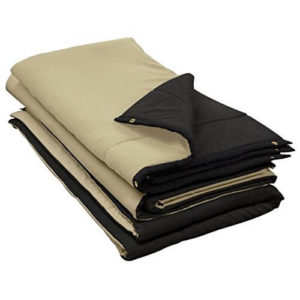
Check price here
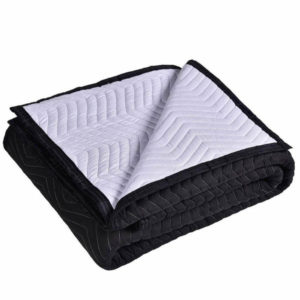
Check price here
2. Soundproof curtains
Similar to blankets, soundproofing curtains can dampen all noises coming or leaving your room.
As the curtains are trap air in them, sound is dampened once it hits through the trapped air.
The Nicetown soundproof curtain that we’ve recommended uses an efficient three-pass microfiber layering to improve noise reduction.
As far as maintenance goes, these dense curtains are actually machine washable and easily cleaned. Although curtains do not offer the same level of sound insulation as soundproofing walls, they will still reduce echoes in a large room.
When installing the curtains, you should note that you may want to look for a curtain rod that can withstand the weight of your new soundproof curtains.
Moreover, the rod should be fixed on your door frame so it does not leave any gaps when you hang your curtain.
If one layer of curtain is not enough to block out the noise, you will need a double curtain rod.
Alternatively, you can use ceiling mount curtain brackets to hang your curtain rod.
This will bring the curtain much closer to the ceiling and effectively block more sound.
Soundproof Curtains
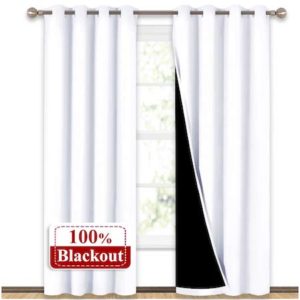
Check price here
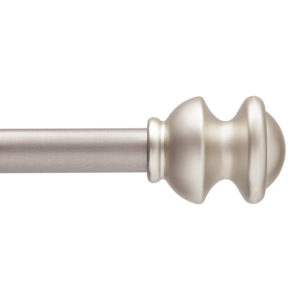
Check price here
3. Acoustic foam
A reliable go-to product when it comes to soundproofing is acoustic foams. This is my go to method for a lot of soundproofing projects as it is relatively cost effective and works really well.
When installed on your door, these foam tiles block noise while absorbing sounds.
As a result, they can eliminate any echoes from the house. Plus, they look quite cool!
Since they are originally designed to improve the acoustics of a music room, you can count them to reduce the amplitude of noise level.
The best part is, they don’t require any special skills to install.
Because they are self-adhesive, it will be a hassle-free process for you.
Acoustic Foam
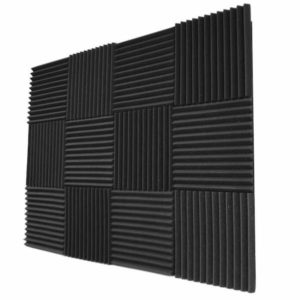
Check price here
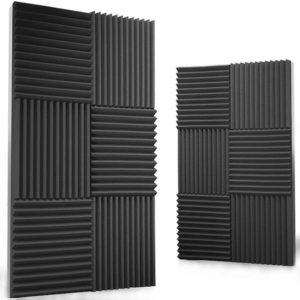
Check price here
4. Door Sweep
To close any existing gaps in your door, you can even install a soundproof door sweep.
Designed to prevent drafts and stop insects from crawling under the door, a door sweep can also stop noise from leaking through the gap.
Door sweeps come in different options, and you will usually find one made of rubber.
They are easy to install. Just measure the width of the door and cut the strip accordingly.
Some models come with adhesive tape that makes installation a breeze.
Gaps are commonly found at doorways, power outlets and windows, so pay more attention to these areas.
Door Sweeps
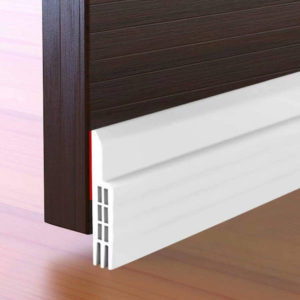
Check price here
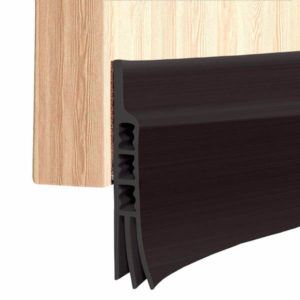
Check price here
5. Weatherstripping tape
Using weatherstripping tape is also another option you can consider to close the gap underneath your door.
In addition to being dust-proof, it can be used for sliding any interior doors in your home.
As it already comes with adhesive tape, it makes it easy to install.
To match the required length to cover the gap over your door, simply cut the tape according to the dimensions and remove the protective paper.
Weatherstripping tape
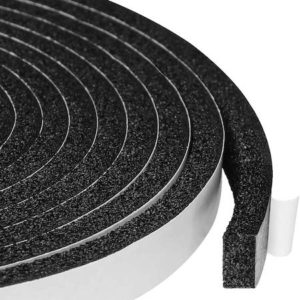
Check price here
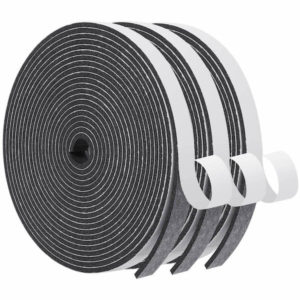
Check price here
Related: How to make a soundproof box
6. Using caulk to cover up holes and gaps
If you discover holes or gaps on your door or door frame, one of the best way to close them up is by using caulk. I highly recommend using Green Glue sealant as it is manufactured to reduce sound transfer.
It might be difficult to spot them, but blowing wind from one side of the door while you inspect on the other side can reveal trouble spots. Feeling air currents would mean there is a gap somewhere, so you will need to identify and cover it up.
Be sure to check your walls too, as they are frequently made of lightweight material. If you have a concrete wall, then this is very unlikely. But for thin walls, you will need to be more careful.
Upon finding the gaps, apply a layer of the sealant and let it rest. Do not touch or apply anything else to it. I am pretty crazy, so I apply the sealant all around my door frame! Use a caulking gun to smooth out the process of applying the sealant.
Green glue acoustic caulk and caulking gun
Check price here
Check price here
7. Stick on Mass Loaded Vinyl (MLV) to thicken the door
If you have no idea what these are, you are in for a treat. These bad boys are the favorite tools of lots of people trying to soundproof their homes. Basically, it is a composite material made of calcium carbonate and polyvinylchloride.
What it does is to increase mass on a surface, which in this case ‘turns’ a hollow door thicker. This translates to less annoying noise being transferred through the door, effectively increasing noise reduction.
MLV is relatively thick, but it is very dense, which is perfect for in this situation where we need to soundproof a door. Plus, it has a slick look and makes your door look even better! Check out the best mass loaded vinyl brands here.
However, you need to treat this as an investment as MLV can be quite expensive. You can use removable tape to attach it to your door though, which makes them easily recyclable.
An alternative that uses similar material is a custom made soundproof barrier for doors. The custom cut out shape can fit any kinds of front doors and is great at reducing noise transfer. This is by far the most expensive method, but worth considering if noise reduction is really important to you. (could be for a music or drum room)
Mass Loaded Vinyl
Check price here
Check price here
Related: Second Skin vs Dynamat: Which is better?
Frequently Asked Questions (FAQ)
How to soundproof metal doors?
What if you have a metal door instead? Typically, they do not block out sound that well, and you can make use of the same steps as above to soundproof them. Unless you have a perforated metal door (very unlikely though), you can pair them up with acoustic sound panels to block out and absorb noise effectively.
What can I do if the DIY solutions still won’t block out any noise completely?
In this case, you can consider getting a solid core door.
Although getting a new solid door is costlier than the DIY solutions we’ve proposed, many customers have noted the significant difference it makes.
There are many types of solid doors to choose from, including hardwood and medium density fiberboard.
To help you make a more informed decision, the materials will usually come with a Sound Transmission Class (STC) rating.
The higher the rating is, the more effective the material is at blocking sounds.
In general, a hardwood, oak or pine door can vary from $100-$600.
What are the household items I can use to soundproof my door?
If you are someone who likes to embark on new DIY projects, you might be interested in using different household items.
You can use old heavy curtains, blankets or even old foam puzzle tiles and yoga mats as an alternative.
Simply tack them onto your door or use a spray adhesive to attach them.
Although this solution might be less aesthetically pleasing, it will definitely do the trick.
Additionally, you can even improvise a draft stopper with towels or pillows.
What are my options if I rent an apartment and have limited options for home improvement projects?
Living in a rented apartment will limit some of your DIY options as you do not want to pay a hefty sum before moving out.
Certainly, replacing your hollow core door will not be an option.
Instead, you can look into acoustic panels, blankets or soundproofing curtains if you currently live in a rented apartment.
Sound-absorbing paint is also an option you can consider as most landlords have no issue with this.
A sound deadening paint is a heavy-bodied, water-based paint that reduces the transmission of sound and also provides a highly reflective heat barrier to the painted surface.
How do I soundproof sliding doors in my apartment?
When it comes to soundproofing sliding doors, you may be hesitant about draping dense curtains or blankets over it.
It is important to look out for the gaps and cracks along the side and beneath the door, as well as the door frame, as they act as a gateway for sound to travel from outside into your house.
To solve this problem, a door sweep will be your best option.
You can also add a self-adhesive weatherstrip on the bottom of your sliding door.
This tape should slide nicely as you’re opening and closing the door without any hindrance.
How to soundproof an apartment door: Conclusion
From the soundproofing solutions that I’ve provided in this article, you can decide what suits your personal needs the best while you consider your budget and space constraints.
Soundproofing a door should not take up too much of your time and budget if you plan accordingly.
Ultimately, it will come at a small cost but that means creating a peaceful environment for you and drowning out the noise that has caused you many sleepless nights.
Additional resources:
- Latest articles on Soundproofing Hacks
- Complete buying guides
- 9 Best Quiet Kettles for a Peaceful Morning Brew
- How to make air conditioner quieter? 6 simple tips that work!
- Does Soundproof Paint Work? Facts You Should Know
- 7 Best Battery Powered Weed Eaters
- How to fix squeaky floors in apartment or home: 8 effective steps




